CAA South Central Ontario (CAA SCO) is proud to recognize Sonia Preston, a teacher at Brookmill Boulevard Junior Public School in Scarborough, as an outstanding road safety ambassador and an integral part of the CAA School Safety Program (CAA SSP) – a program that teaches children life-long leadership skills on how to interact in a busy world with the confidence to be able to act in emergency situations.
Preston is the winner of the CAA School Safety Patrol Supervisor of the Year and was nominated by Brookmill Boulevard Junior Public School Principal Helena Syptak.
For 21 years, Preston has been part of the CAA School Safety Patrol program, acting as a Patrol Supervisor and trusted member of the community. Going above and beyond her duties, she consistently maintains a visible presence during peak traffic hours, providing guidance and support to Patrollers as they fulfil their duties by conducting regular training sessions to equip Patrollers with the skills to handle various traffic scenarios with poise and precision.
“Ms. Preston's volunteerism, commitment, dependability, and leadership are the cornerstones of our Safety Patrol program's success,” says Syptak. “Her efforts above and beyond the expected Patrol Supervisor role have made a lasting impact on our school community, enriching the lives of countless students and inspiring them to become responsible leaders and compassionate citizens.”
The CAA School Safety Patrol program was developed in 1929 to protect, educate, and empower elementary school children on safe road-crossing practices. With more than 90 years of proven experience in teaching road safety and children’s safety in school zones, the program gives Patrollers an acute awareness of road safety and gives them the tools to help them stay safe as they travel to and from school.
Preston's commitment to promoting pedestrian safety goes beyond the school grounds. She has actively engaged with local authorities and community stakeholders, such as the School Advisory Council, to address traffic concerns in the surrounding area, advocating for improved infrastructure and implementing strategies to mitigate potential hazards.
“Ms. Preston leads by example, demonstrating integrity, compassion, and resilience in everything she does,” says Syptak “Her ability to inspire and motivate others has a profound impact on patrollers, instilling in them a sense of purpose and pride in their roles. Under her guidance, patrollers not only fulfil their duties with excellence but also emerge as confident leaders and responsible citizens.”
We thank Sonia Preston for being a local hero in her community and advocating for road safety in her everyday life.
Since its start, the CAA School Safety Patrol program has helped keep students safe in school zones. Every year, approximately 800 schools in Ontario participate in the CAA SSP program, which CAA SCO delivers with local partners.
For more information on the program, visit www.caaschoolsafetypatrol.com





